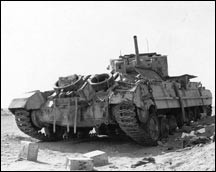| Folgore
at Alamein
By Mike Bennighof, Ph.D.
June 2017
 Contrary
to well-cherished myth among game players,
the German high command did not withhold reinforcements
from the North African theater due to an inability
to supply them there. While resupply might
have been difficult, the question was also
purely theoretical: The panzer divisions desired
by Erwin Rommel could only come from the Eastern
Front, and there were none to spare. Contrary
to well-cherished myth among game players,
the German high command did not withhold reinforcements
from the North African theater due to an inability
to supply them there. While resupply might
have been difficult, the question was also
purely theoretical: The panzer divisions desired
by Erwin Rommel could only come from the Eastern
Front, and there were none to spare.
The Royal Italian Army proved more willing
to commit troops to the desert campaign, but
faced a different problem: a shortage of formations
trained and especially equipped for the mobile,
modern warfare being waged in Libya and Egypt.
In the summer of 1942 Italy had finally produced
enough tanks to both replace losses in its
one armored division fighting there and send
a second to join it. In addition to mechanized
formations, the Italian high command believed
that elite light infantry also had a place
in desert warfare if supported by armored
units.

Folgore parachutists during training.
|
Among these elite formations eventually tabbed
for desert service was the 185th “Folgore”
Parachute Division. The unit figures prominently
in our very large Alamein game.
Though lacking in combat power in the game,
especially anti-tank weapons, Folgore’s
paratroopers have immensely high morale.
Parachute troops were seen as a very modern
symbol of the fascist state, and Italy was
quick to adopt the idea. The Army authorized
its first battalion in 1936, the same year
that the Air Force began small-scale jump
training. Formed by the experience of Spain
and Ethiopia, Italian thinking did not initially
foresee large formations landing by parachute,
but rather small groups to cause disruption
and sabotage.

Parachutists in the desert, some months
later.
|
Marshal Italo Balbo formed the first colonial
parachute unit in 1938 in Libya, staffing his
“Air Infantry Regiment” with “volunteers”
from the Libyan colonial troops and officers
from both the Army and Air Force. They trained
at a jump school near Tripoli, and in 1940 the
army opened its own mainland training center
at Tarquina. Training progressed only slowly
as technical glitches with the parachutes kept
killing trainees, but two battalions of regular
army paratroopers were soon formed, and the
Royal Carabinieri (Italy’s militarized
police) formed its own parachute company as
well. In March 1941 a German-designed parachute
replaced the Italian model, and the pace of
training quickened considerably. All parachutists
were volunteers, and the branch had the pick
of most of the army’s non-commissioned
and junior officers — small-unit leadership,
a weakness in most Italian formations, therefore
was a strength among the paratroopers.
The army’s commitment grew, and on
1 September 1941 the 1st “Folgore”
Parachute Division officially came into being,
followed soon afterwards by the 2nd “Nembo”
Parachute Division. The decision to form a
second division siphoned off one of Folgore’s
regiments, slowing the division’s development,
and Nembo never became fully operational,
either.

Lt. Gianpaolo directs one of Folgore’s
few anti-tank guns.
|
Small groups of Italian paratroopers landed
on Zante and Cephalonia in April 1941 and
made a raid on Cyprus as well. Italian planners
considered attacks on the Suez Canal and a
large-scale drop into Italian East Africa.
But the real target was the island fortress
of Malta, and Folgore trained hard for the
operation alongside several German parachute
battalions.
Operazione C3, as the Italians called the
attack, was cancelled in June 1942. On 14
July 1942 Folgore was alerted for transfer
to Africa, and air transport began within
a few days. On the 27th the division was renamed
the 185th “Cacciatori d’Africa”
Infantry Division, but Italian reports refer
to it as the 185th “Folgore” Parachutist
Brigade.
The “division” left behind several
of its battalions to strengthen the Nembo
Division, re-numbered 184th at the same time.
“Brigade” was an accurate appraisal,
with between 3,000 and 3,500 troops when the
British attacked the Alamein line in October
1942. However, the troopers had gone to Africa
with considerably more automatic weapons than
allocated by their official establishment,
and acquired more after landing. This helped
redress the manpower shortage to some extent.
Folgore had seven small parachute battalions
at that time (V and VI under 186th Regiment;
II, IV, IX and X under 187th Regiment, and
VII operating independently), plus a strong
parachute assault engineer battalion (Italian
records are inconsistent on whether the assault
engineers, known as guastatori, are included
in the Folgore troop total or not). A number
of assets from other divisions had also been
attached: a combat engineer battalion (though
sometimes rendered “guastatori”
in English-language descriptions, these troops
were similar but not identical to assault
engineers), one artillery and one infantry
battalion from the Pavia Division, an artillery
battery from the Brescia Division, a battery
of the deadly 88mm or 90mm anti-aircraft guns
(Italian records differ as to which) from
the Ariete Armored Division, an anti-tank
company from the V Bersaglieri Battalion,
and a German tank platoon from the 21st Panzer
Division.

Gen. Enrico Frattini led Folgore at
Alamein.
|
X Parachute Battalion came to Africa already
understrength and suffered heavy casualties
in the British attack known as Operation Beresford
in September, though it inflicted more than
10 times its own losses on the British 131st
Infantry Brigade. By the time of the Alamein
battles it was down to company strength and
fighting under IX Battalion’s command.
II Parachute Battalion brought only two of
its companies to Africa; the third (6th Parachute
Company) remained in Tarquina as training
cadre. The 185th Parachute Artillery Regiment
brought only three company-strength “gruppi”
of 47mm anti-tank guns, and the 20th Mortar
Company of two platoons with 81mm tubes.
When the British attack came on 23 October
1942, Folgore manned a division-sized sector
despite its low strength. Four enemy divisions
(44th and 50th British Infantry, 7th British
Armoured, and 1st Free French) attacked the
parachute brigade’s lines.

One of at least 31 British tanks destroyed
by Folgore troopers on 25 October 1942.
|
The paratroopers repulsed repeated attacks,
routing the French and driving back the British.
Folgore’s men followed a unique (and perilous)
tactic used by IX and X battalions during the
September fighting: allowing the British tanks
to penetrate their positions, then ambushing
them from multiple directions with hunter-killer
teams hidden in camouflaged dugouts. Folgore’s
war diary claims 110 tanks destroyed in a single
day, but only 31 hulks remained on the battlefield
— Gen. Enrico Frattini blamed his attached
combat engineer battalion for disobeying his
orders to finish off abandoned British tanks
with demolition charges. And echoing German
practice of abusing their allies, the brigade
staff accused the attached German tank platoon
of cowardice in the face of the enemy.

Folgore paid a price.
|
After three days of heavy fighting, the British
abandoned their assaults on the southern end
of the Axis line where Folgore stood and re-focused
on the opposite flank. There they had much
more success, and on 2 November Folgore received
orders to withdraw. Lacking motor transport,
most of the paratroopers were lost in the
retreat, though a small band fought its way
all the way across Libya and saw action in Tunisia
as the 285th “Folgore” Parachute
Battalion.
While Italy fielded a number of fine units
during the Second World War, parachute veterans considered
Folgore the best of them. For hard fighting
in a despicable cause, they may have been right.
Click here to order Alamein right now!
Mike Bennighof is president of Avalanche Press and holds a doctorate in history from Emory University. A Fulbright Scholar and award-winning journalist, he has published over 100 books, games and articles on historical subjects.
He lives in Birmingham, Alabama with his wife, three children and his dog, Leopold. Leopold prefers ready access to water.
|
